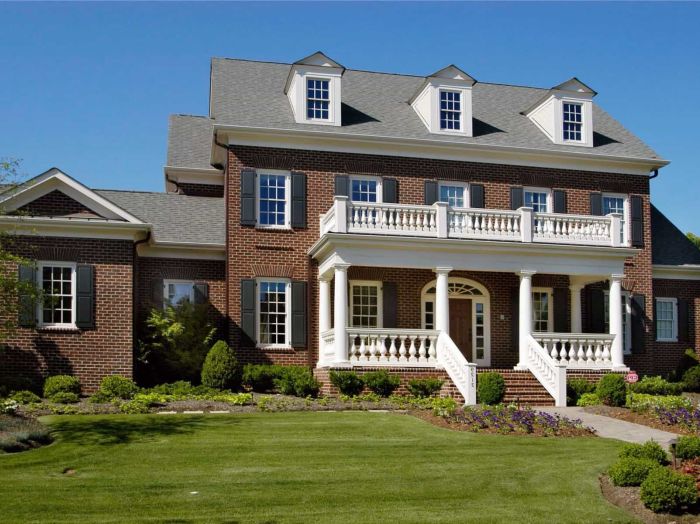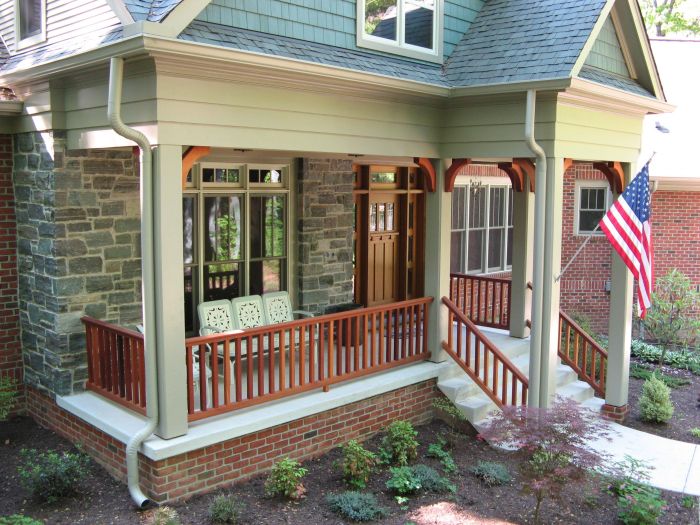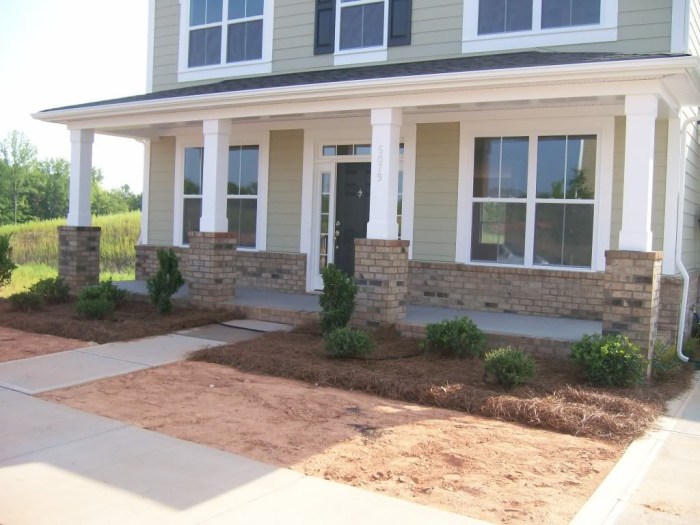Brick pillars are a classic and versatile architectural element that can add both beauty and functionality to your porch. They can define the entrance to your home, provide support for a roof or awning, and create a sense of privacy.
In this comprehensive guide, we will explore the different types of brick pillars, discuss their construction and maintenance, and provide tips for choosing the perfect pillars for your porch.
From traditional red brick to modern glass block, there are endless possibilities when it comes to choosing brick pillars for your porch. The type of brick you choose will depend on the overall style of your home, the desired level of maintenance, and your budget.
Once you have selected the perfect bricks, it is important to follow proper construction techniques to ensure the structural integrity of your pillars.
Introduction
Brick pillars for porch are structural columns made of bricks, typically used to support the roof or overhang of a porch. They provide both aesthetic and functional benefits, enhancing the overall appearance and stability of the porch.
Purpose and Benefits
Brick pillars for porch serve several purposes and offer various benefits:
- Structural Support: Brick pillars are highly durable and can withstand significant weight, providing reliable support for the porch roof and preventing sagging or collapse.
- Aesthetic Appeal: Brick pillars add a touch of elegance and charm to the porch, complementing the architectural style of the house and creating a welcoming entrance.
- Weather Resistance: Bricks are resistant to moisture, weathering, and pests, ensuring the pillars’ longevity and durability in various climates.
- Customizable Design: Brick pillars can be customized in terms of size, shape, and color to match the specific design and aesthetic preferences of the homeowner.
- Increased Value: A well-maintained porch with brick pillars can increase the curb appeal and overall value of the property.
Types of Brick Pillars
Brick pillars come in a wide range of styles and designs, each with its own unique characteristics. The type of brick used, as well as the pillar’s shape and dimensions, can significantly impact its overall appearance and functionality.
Brick Materials
The choice of brick material plays a crucial role in determining the durability, aesthetics, and cost of the pillar. Common types of bricks used for pillars include:
- Clay Bricks: Made from natural clay, these bricks are versatile, durable, and come in various colors and textures.
- Concrete Bricks: Stronger than clay bricks, concrete bricks are often used in load-bearing applications and offer a more modern aesthetic.
- Sand-Lime Bricks: These bricks are made from a mixture of sand, lime, and water, and are known for their high strength and resistance to moisture.
Pillar Designs and Shapes
Brick pillars can be designed in various shapes and styles to complement the architectural style of the home or building. Some popular pillar designs include:
- Square Pillars: Simple and classic, square pillars are versatile and can be used in a wide range of applications.
- Round Pillars: These pillars add a touch of elegance and sophistication to any space, and can be used to create a more open and inviting atmosphere.
- Octagonal Pillars: With their eight-sided shape, octagonal pillars offer a unique and visually interesting alternative to traditional square or round pillars.
Factors to Consider When Choosing Brick Pillars
When selecting brick pillars, several factors should be taken into account:
- Load-bearing Capacity: The pillar’s ability to support weight is crucial, especially for structural applications.
- Aesthetic Appeal: The pillar’s design, shape, and color should complement the surrounding architecture.
- Durability: The brick material and construction methods should ensure the pillar’s longevity and resistance to weathering.
- Cost: The cost of the pillar, including materials, labor, and installation, should fit within the project budget.
Construction of Brick Pillars
Building brick pillars involves meticulous planning and skilled craftsmanship. Follow these step-by-step instructions to construct sturdy and aesthetically pleasing pillars:
Materials and Tools
- Bricks: Choose high-quality bricks with consistent dimensions and minimal defects.
- Mortar: Prepare a mortar mix of sand, cement, and water in the appropriate proportions.
- Level: Ensure accurate leveling throughout the construction process.
- Trowel: Spread and shape the mortar smoothly.
- Jointer: Create neat and uniform joints between bricks.
- Brick hammer: Break bricks to create custom sizes or shapes.
- Plumb bob: Verify the vertical alignment of the pillars.
Laying the Foundation
Excavate the area for the foundation, ensuring a depth below the frost line. Pour a concrete footing and allow it to cure thoroughly.
Building the Pillar
Lay the first course of bricks on the footing, checking for level and squareness. Apply mortar to the top of each brick and lay the next course, staggering the joints for increased stability. Use a level to ensure each course is horizontal and a plumb bob to maintain vertical alignment.
Continue building the pillar to the desired height, using the appropriate bond pattern (such as running bond or Flemish bond).
Creating Joints
Use a jointer to shape the mortar joints between bricks. Strike the joints either flush, recessed, or raked for a decorative effect.
Finishing the Surface
Once the mortar has set, brush away any excess and smooth the surface of the pillar. Apply a sealant or paint to protect the bricks from moisture and enhance their appearance.
Maintenance and Repairs
Regular maintenance is essential to ensure the longevity and aesthetics of brick pillars. Cleaning, sealing, and repairing any damage promptly will help preserve their integrity.
Common problems associated with brick pillars include:
- Cracks and chips
- Efflorescence (white powdery deposits)
- Mold and mildew growth
- Structural instability due to settlement or foundation issues
Cleaning
Regular cleaning removes dirt, grime, and debris that can damage the bricks over time. Use a soft brush or sponge with a mild detergent solution. Avoid harsh chemicals or pressure washers that can erode the mortar.
Sealing
Applying a water-repellent sealant helps protect the bricks from moisture penetration, which can cause efflorescence and freeze-thaw damage. Choose a breathable sealant that allows moisture vapor to escape while preventing water from entering.
Repairing
Cracks and chips can be repaired using a mortar mix that matches the color and texture of the existing bricks. Remove loose debris, apply the mortar, and smooth it out with a trowel. For larger cracks or structural issues, consult a professional mason.
Aesthetic Considerations
Brick pillars have been an integral part of architectural styles for centuries, adding character and elegance to both traditional and modern homes. Their versatility allows them to complement various architectural styles, from classic to contemporary, and they can significantly enhance the aesthetics of any porch.
The choice of brick pillars should complement the overall design of the house. For example, a traditional Victorian home might feature brick pillars with intricate detailing, while a modern minimalist home might opt for clean-lined, square pillars. The size and shape of the pillars should also be proportionate to the size of the porch and the house itself.
Architectural Styles
Brick pillars are commonly incorporated into architectural styles such as:
- Colonial: Red brick pillars with white trim are a classic feature of Colonial homes, evoking a sense of history and charm.
- Georgian: Georgian homes often feature symmetrical brick pillars with a grand entrance, creating an imposing and stately appearance.
- Federal: Federal-style homes typically use brick pillars with slender proportions and delicate details, adding a touch of elegance and refinement.
- Greek Revival: Greek Revival homes often incorporate tall, fluted brick pillars inspired by ancient Greek architecture.
- Italianate: Italianate homes may feature brick pillars with rounded arches and decorative moldings, adding a touch of Mediterranean flair.
Safety and Building Codes
Working with brick pillars requires adherence to safety precautions to prevent accidents and injuries. Proper protective gear, such as gloves, safety glasses, and a hard hat, is essential. Handling bricks can be strenuous, so it’s important to lift them correctly to avoid back injuries.
Moreover, using scaffolding or ladders safely is crucial for working at heights.
Building Codes and Regulations
Brick pillars must comply with building codes and regulations to ensure structural integrity and safety. These codes vary by region, so it’s essential to consult local authorities for specific requirements. Generally, codes address aspects like minimum pillar dimensions, reinforcement, and load-bearing capacity.
Adhering to these regulations ensures that brick pillars can withstand the intended loads and environmental conditions.
Conclusion
Whether you are looking to add a touch of elegance to your porch or simply improve its functionality, brick pillars are a great option. By following the tips and advice in this guide, you can choose, build, and maintain beautiful and durable brick pillars that will enhance your home’s curb appeal for years to come.



